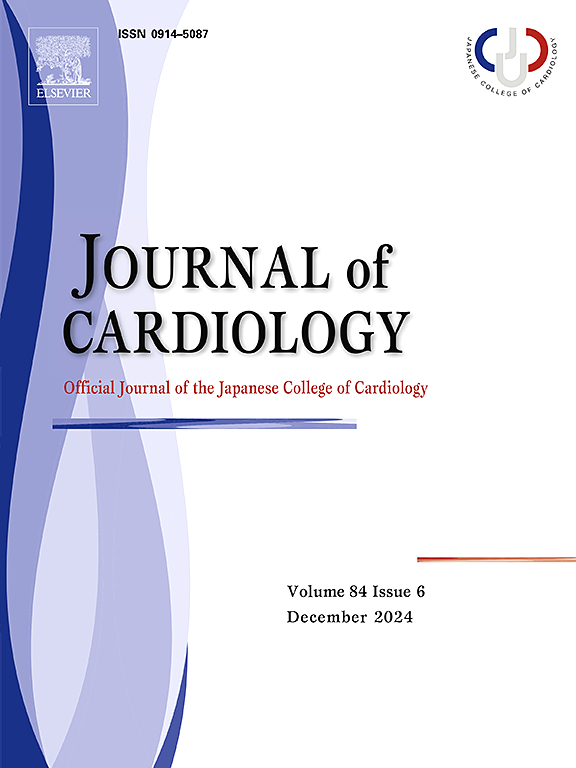Clinical implications of malnutrition on 30-day adverse events in patients with Takotsubo syndrome
IF 2.6
3区 医学
Q2 CARDIAC & CARDIOVASCULAR SYSTEMS
引用次数: 0
Abstract
Background
The impact of malnutrition on clinical outcomes in patients with takotsubo syndrome (TTS) is poorly understood. The purpose of this study was to investigate the relationship between malnutrition on admission and 30-day adverse events in patients with TTS.
Methods
We retrospectively evaluated 124 consecutive patients admitted for TTS at our hospital from April 2013 to July 2023. Malnutrition was assessed at admission using the Geriatric Nutritional Risk Index (GNRI), which is an objective and simple nutritional assessment method. Malnutrition was defined as GNRI <92. We defined 30-day adverse events as the composite of all-cause death, acute heart failure, cardiogenic shock, life-threatening arrhythmia, thrombotic events, and stroke. The primary endpoint was the comparison of the 30-day adverse event rates between patients with and without malnutrition.
Results
The median age was 78.0 (70.0–83.0) years, and 77 % of the patients were women. The median GNRI was 90.8 (81.5–98.0) and 55 % had malnutrition. The 30-day adverse events were shown in 64 patients. Compared with patients without malnutrition, the 30-day adverse event rate was significantly higher in those with malnutrition (32 % vs. 68 %, respectively; log-rank test p = 0.0001). The multivariable Cox proportional hazards model revealed that malnutrition was independently associated with high 30-day adverse event rates adjusted by age, female sex, malignancy, B-type natriuretic peptide, and high-sensitivity C-reactive protein (hazard ratio: 1.97, 95 % confidence interval: 1.08–3.58; p = 0.02).
Conclusions
Malnutrition at admission was associated with high 30-day adverse event rates. Early identification and a considered treatment strategy for malnutrition are important in patients with TTS.

营养不良对Takotsubo综合征患者30天不良事件的临床意义
背景:营养不良对takotsubo综合征(TTS)患者临床结局的影响尚不清楚。本研究的目的是探讨入院时营养不良与TTS患者30天不良事件之间的关系。方法:回顾性评估2013年4月至2023年7月在我院连续收治的124例TTS患者。入院时采用老年人营养风险指数(Geriatric nutrition Risk Index, GNRI)进行营养不良评估,这是一种客观、简便的营养评估方法。结果:中位年龄78.0(70.0 ~ 83.0)岁,77 %患者为女性。GNRI中位数为90.8(81.5-98.0),55% %营养不良。64例患者出现30天不良事件。与没有营养不良的患者相比,营养不良患者的30天不良事件发生率明显更高(分别为32 %对68 %;Log-rank检验p = 0.0001)。多变量Cox比例风险模型显示,营养不良与高30天不良事件发生率独立相关,经年龄、女性性别、恶性肿瘤、b型利钠肽和高敏c反应蛋白校正(风险比:1.97,95 %可信区间:1.08-3.58; = 0.02页)。结论:入院时营养不良与较高的30天不良事件发生率相关。对TTS患者来说,早期发现营养不良和考虑周全的治疗策略是很重要的。
本文章由计算机程序翻译,如有差异,请以英文原文为准。
求助全文
约1分钟内获得全文
求助全文
来源期刊

Journal of cardiology
CARDIAC & CARDIOVASCULAR SYSTEMS-
CiteScore
4.90
自引率
8.00%
发文量
202
审稿时长
29 days
期刊介绍:
The official journal of the Japanese College of Cardiology is an international, English language, peer-reviewed journal publishing the latest findings in cardiovascular medicine. Journal of Cardiology (JC) aims to publish the highest-quality material covering original basic and clinical research on all aspects of cardiovascular disease. Topics covered include ischemic heart disease, cardiomyopathy, valvular heart disease, vascular disease, hypertension, arrhythmia, congenital heart disease, pharmacological and non-pharmacological treatment, new diagnostic techniques, and cardiovascular imaging. JC also publishes a selection of review articles, clinical trials, short communications, and important messages and letters to the editor.
 求助内容:
求助内容: 应助结果提醒方式:
应助结果提醒方式:


